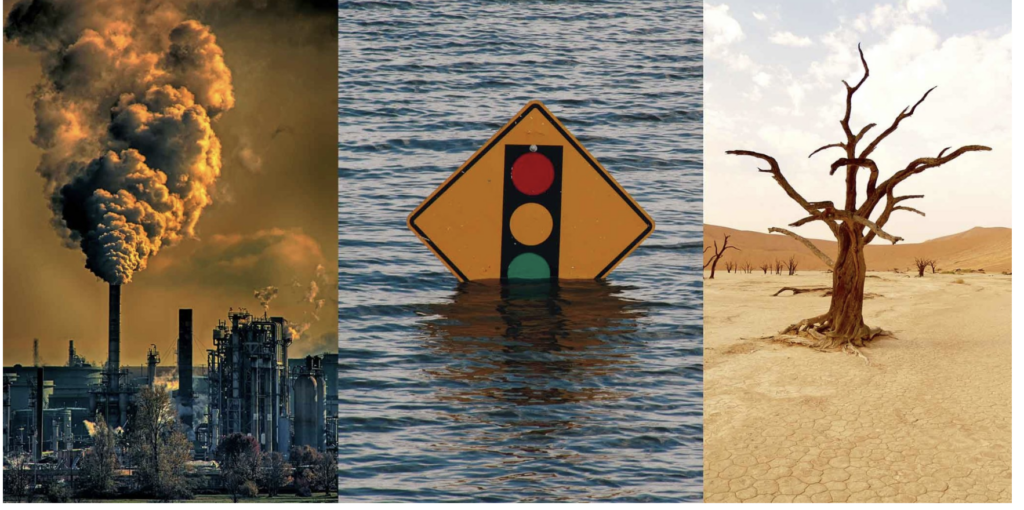Village Voice: In September 2021, New York City experienced historic and catastrophic flooding from the remnants of Hurricane Ida. Streets turned to rivers, cars flooded and were left abandoned, people drowned in their own basements. This writer dodged waterfalls in the subway before arriving home to find a room slowly filling with water gurgling up through the toilet. Never designed to handle such a large volume of rainfall in such a short time, Ida challenged the city’s 100-year-old sewer system.
Ida’s devastation made the consequences of global climate change all the more apparent. An overall increase in temperatures across the planet has created a spectrum of dramatic environmental change. A record lack of snow in New York City this past winter, catastrophic snowstorms upstate, a devastating drought followed by flooding rains in California — these are all examples of the aberrant weather systems long predicted by climate scientists. And although wildfires are not directly caused by climate change, “Many environmental impacts associated with climate change can affect the severity and timing of the wildfire season,” according to the EPA, exposing populations to hazardous air quality conditions such as those experienced this past month, caused by out-of-control Canadian wildfires.
Current climate models point to rising temperatures intensifying the water cycle and increasing evaporation, resulting in more frequent storms and severe droughts. Since 2020, New York City has seen almost as many hurricanes and tropical storms as it did from 2010 to 2019; three were in the top 10 recorded “max hourly precipitation” events: Elsa (the first of the 2021 hurricane season) came in at No. 9, and Henri (third in 2021) broke the previous record from the remnants of Hurricane Frances, only to have that record broken less than two weeks later by Ida.
The correlation is obvious to Joseph Heathcott, associate professor of Urban Studies and Design at the New School, who told the Voice in an email, “The overarching driver of increased storm strength and activity is climate change.” Without addressing climate change by massively reducing greenhouse gas production, he explains, “there not only could be worse flooding, there will be. If ocean and atmospheric temperatures continue to rise and water levels increase, there will be more storms that bring amplified destruction.” Bhawani Venkataraman, associate professor of chemistry at the New School, who also teaches climate science, agrees, responding to the Voice via email: “With the amount of GHGs [greenhouse gasses] already in the atmosphere, the planet will warm, and that will drive further climate change, even if we were to stop emissions of GHGs soon.”
This is not “new” news. In the 1860s, John Tyndall, an Irish physicist, discovered the “greenhouse effect.” In 1896, Svante Arrhenius, a Swedish scientist, predicted that changes in CO2 levels in the atmosphere would affect the earth’s surface temperature through Tyndall’s greenhouse effect, causing global warming. In 1938, inventor Guy Callendar formally observed Arrhenius’s prediction in weather station data. In 1956, scientist Gilbert Plass published The Carbon Dioxide Theory of Climatic Change. Since global climate change was not addressed when scientists and researchers first became aware of it and began issuing warnings, as they have through the decades to the present day, we now have to fight two battles: one against the rising rate of carbon pollution and one against the already materializing effects of that pollution.
New York City is beginning to take action on these two battlefronts. But bureaucracy and controversy are not far behind.
The city was sluggish in its response to climate change after Hurricane Sandy, which hit in 2012, but the Climate Leadership and Community Protection Act (Climate Act), which was passed in 2019 and considered the most progressive climate law in the country, set a goal of achieving 100% zero-emissions electricity by 2040. Also in 2019, the City Council released Let’s Go: A Case for Municipal Control and a Comprehensive Transportation Vision for the Five Boroughs, a plan to reduce emissions and build climate resilience, and in 2020 put out Securing Our Future: Strategies for New York City in the Fight Against Climate Change. However, Ida’s depredations in 2021 made clear that this would not be enough. In the days after Ida, the Voice spoke with Council Member James Gennaro, who acknowledged that the city’s infrastructure is outdated. Although, he also asserted, “No sewer system in the world is capable of absorbing the type of historic rainfall we saw with Ida.”
Unfortunately, Securing Our Future was released days before the Covid-19 lockdown began, greatly slowing progress on that front as the city dealt with, and continues to deal with, issues surrounding the global pandemic. And some of the strategies put forward would require help from outside the city. Let’s Go had proposed redesigning streets that cater to cars to better accommodate bikes and buses, and much progress has been made in widening access and making room for bicycle traffic. But further advancements met delays, because the MTA is controlled by the governor and the New York State Legislature but the city is responsible for streets and sidewalks. (The report urged the state to relinquish control of the MTA.) Securing Our Future requires cooperation with Con Edison to invest in grid infrastructure to optimize it for clean energy, and cooperation from the state to increase oversight of Con Edison. Read more>>
